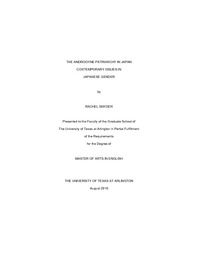| dc.contributor.author | Snyder, Rachel Ann | en_US |
| dc.date.accessioned | 2010-11-01T21:28:49Z | |
| dc.date.available | 2010-11-01T21:28:49Z | |
| dc.date.issued | 2010-11-01 | |
| dc.date.submitted | January 2010 | en_US |
| dc.identifier.other | DISS-10730 | en_US |
| dc.identifier.uri | http://hdl.handle.net/10106/5120 | |
| dc.description.abstract | This project seeks to identify recent trends in Japanese masculinity, particularly the inclusion of androgyny as a mode included in masculinity. The salary man is perhaps the best-known model of masculinity in Japan identifiable to the West; but recently, Japan has seen some interesting developments in acceptable forms of performable masculinity. In the first chapter of this thesis especially I deal with a historical analysis of three different historical models of Japanese inclusive masculinity. The second chapter looks at the contemporary counterpart to the mobo, the hikikomori, or shut in through an analysis of the writings of Haruki Murakami. The final chapter is an analysis of a genre of musical performance art known as Visual kei. I look at what it means in terms of subverting Western gender binaries; however, I find that this music style exemplifies a kind of androgyny as masculinity that upholds Japanese gender binaries. | en_US |
| dc.description.sponsorship | Faris, Wendy | en_US |
| dc.language.iso | en | en_US |
| dc.publisher | English | en_US |
| dc.title | The Androgyne Patriarchy In Japan: Contemporary Issues In Japanese Gender | en_US |
| dc.type | M.A. | en_US |
| dc.contributor.committeeChair | Faris, Wendy | en_US |
| dc.degree.department | English | en_US |
| dc.degree.discipline | English | en_US |
| dc.degree.grantor | University of Texas at Arlington | en_US |
| dc.degree.level | masters | en_US |
| dc.degree.name | M.A. | en_US |

